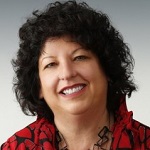Diane Kaplan, Rasmuson Foundation
 Title: President and CEO
Title: President and CEO
On the job since: 1995 (CEO since 2001)
Foundation founded in: 1955
Geographic scope: Alaska
Grants made in 2015: $28M
Staff: 20 FTE
Percentage of staff representing communities of color: 33%
How did you come to the decision to host a Momentum Fellow?
Shortly before the launch of the Momentum Fellow program at Philanthropy Northwest, Rasmuson Foundation had hired two fellows — one in Communications and another in Programs. Although we have hosted interns many times in the past, the creation of a fellowship program was a new approach for us. We designed it to be a two-year commitment for an educated emerging professional to launch a career in philanthropy and/or the nonprofit sector in Alaska. About six months into our fellowship, Philanthropy Northwest created the Momentum Fellowship, and through Rasmuson Foundation’s membership and involvement in the CEO cohort on diversity, equity and inclusion, we learned about the opportunity. Most if not all of the other Momentum Fellows were hired expressly to be in the cohort, whereas Kelsey Potdevin was already employed here [in Programs] when the cohort was formed. We believed that the Momentum Fellowship experience would enrich and enhance Kelsey’s fellowship, and Philanthropy Northwest agreed to be flexible in allowing Kelsey to join the cohort.
What has been a challenge for you and your foundation, related to diversity, equity and inclusion in philanthropy, and how are you working on it?
When recruiting for open positions, we often find that the applicant pool does not reflect the diversity of Alaska’s population. We realized that it might be the result of the search firm we are using, the language we use in our job postings, the places where we post those openings, or all of those. In our most recent hiring process for a program officer position, we changed the language of the job posting so that it reflected our core values up front, and we also challenged our search firm to use recruitment strategies designed to reach applicants who might not know about philanthropy as a career opportunity. We specified characteristics that would resonate with the type of applicant we wanted to see, such as stating that we wanted applicants who had direct experience in rural Alaska.
We have found that direct outreach helps with communities and groups that are under-represented in our grantmaking but it takes more than one interaction. To mitigate some of the cultural disconnect between us and non-Western groups, it sometimes requires guiding the applicant through our processes, which is staff-intensive. In order to review a proposal with a strengths perspective, we may have to spend time getting to know a community or group better to understand what’s important to them — again, this is time-consuming.
What have you and your foundation learned from hosting a Momentum Fellow?
The biggest takeaway is the importance of the cohort experience for fellows. The difference between the experience of our Communications Fellow (who did not participate in Momentum) and Kelsey’s was significant. In-depth interviews with both fellows indicate that the Momentum Fellowship added so much value to Kelsey’s experience. Kelsey learned more about philanthropy in general, and she had a forum within which to explore the social inequities that can be unintentional byproducts of the structural underpinnings of organized philanthropy. Kelsey also benefitted greatly from the exposure to Philanthropy Northwest’s considerable understanding of DEI as related to philanthropy and the individual coaching was hugely helpful to her.

What would success look like for philanthropy and diversity, equity and inclusion?
That the boards and staff of foundations are representative of the people where they live and/or the people they wish to serve. Recipient organizations whose leadership is diverse and inclusive. Policies and practices to ensure that the support offered by a foundation is relevant and accessible to everyone.
What advice would you give to other foundations interested in hosting a Momentum Fellow and/or integrating diversity, equity and inclusion into their work?
Do it! Host a Momentum Fellow! Also, Kelsey was the only Alaska-based fellow and we would advise that a local cohort would be ideal. Kelsey felt she had a somewhat isolated experience compared to her cohort peers.
As for integrating DEI into our work, I’m not sure we are in a position to impart specific advice to others because we struggle with this ourselves; it’s a work in progress. However, it’s clear that philanthropic organizations need to be diligently assessing whether they are relevant and accessible to all the people we want to reach and/or serve. And we should strive to be consistently intentional and deliberate in making changes when that assessment reveals that we are falling short.
What’s a resource you would recommend to funders interested in learning more about this work?
D5 Coalition literature and Philanthropy Northwest.
Diane Kaplan is president and CEO of Rasmuson Foundation, working with Momentum Fellow Kelsey Potdevin.
Learn more about our nine Momentum Fellows and five foundations supporting this fellowship in our July 2016 Virtual Roundtable.